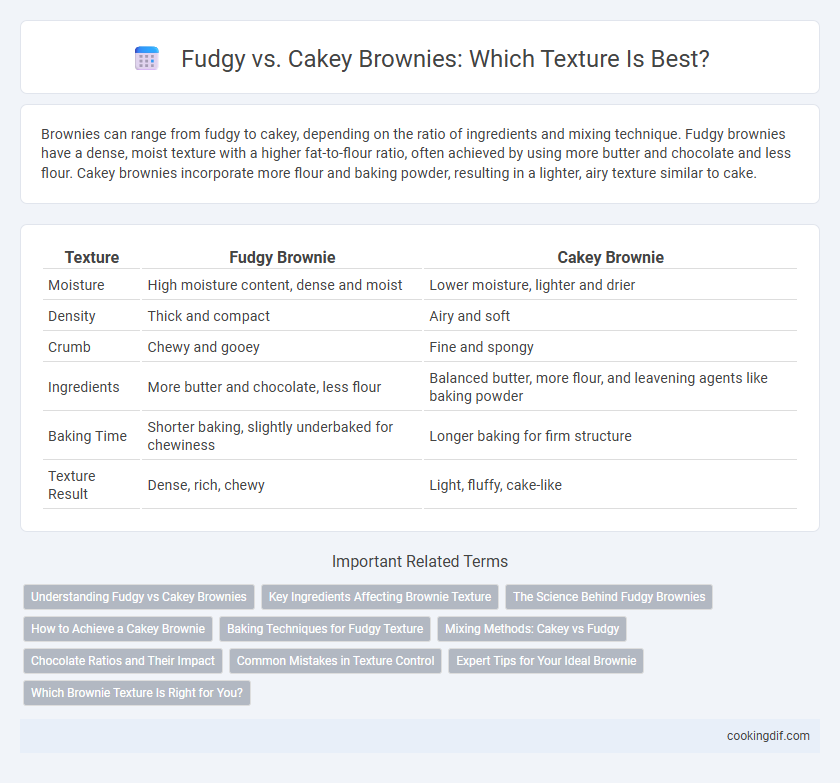Brownies can range from fudgy to cakey, depending on the ratio of ingredients and mixing technique. Fudgy brownies have a dense, moist texture with a higher fat-to-flour ratio, often achieved by using more butter and chocolate and less flour. Cakey brownies incorporate more flour and baking powder, resulting in a lighter, airy texture similar to cake.
Table of Comparison
| Texture | Fudgy Brownie | Cakey Brownie |
|---|---|---|
| Moisture | High moisture content, dense and moist | Lower moisture, lighter and drier |
| Density | Thick and compact | Airy and soft |
| Crumb | Chewy and gooey | Fine and spongy |
| Ingredients | More butter and chocolate, less flour | Balanced butter, more flour, and leavening agents like baking powder |
| Baking Time | Shorter baking, slightly underbaked for chewiness | Longer baking for firm structure |
| Texture Result | Dense, rich, chewy | Light, fluffy, cake-like |
Understanding Fudgy vs Cakey Brownies
Fudgy brownies are characterized by a dense, moist texture with a higher fat-to-flour ratio, often achieved by using more butter and less flour, resulting in a rich, gooey bite. Cakey brownies have a lighter, airy texture akin to cake, produced by incorporating more flour, baking powder, and eggs, which create a well-risen, tender crumb. Understanding the balance of ingredients and baking time is crucial to mastering the desired fudgy or cakey brownie texture.
Key Ingredients Affecting Brownie Texture
Brownie texture is primarily influenced by the ratio of fat to flour and the type of fat used; higher butter or oil content creates fudgy brownies, while increased flour produces a cakey consistency. Eggs contribute moisture and structure, with more eggs leading to a cakier texture due to their leavening and binding properties. Sugar not only sweetens but also affects tenderness, with granulated sugar promoting a firmer crumb and brown sugar enhancing moistness for fudgier results.
The Science Behind Fudgy Brownies
Fudgy brownies achieve their dense, moist texture through a higher fat-to-flour ratio and less leavening agent compared to cakey brownies, resulting in minimal crumb structure. The science behind fudgy brownies involves balancing melted butter and chocolate with sugar to create a glossy, crackly top while maintaining a moist interior. Proper baking time and temperature are crucial to prevent overbaking, which can dry out the brownies and diminish their characteristic fudgy texture.
How to Achieve a Cakey Brownie
To achieve a cakey brownie texture, use a higher ratio of flour to fat and incorporate leavening agents like baking powder or baking soda to create lift. Whipping eggs or adding a small amount of milk helps introduce air, resulting in a lighter, more tender crumb. Reducing the butter and increasing sugar slightly also fosters the soft, cakey structure distinct from fudgy brownies.
Baking Techniques for Fudgy Texture
Achieving a fudgy brownie texture relies on using a higher fat-to-flour ratio, often incorporating melted butter or oil and limiting flour to avoid a cakey density. Intensifying moisture retention by reducing baking time and using less leavening agents like baking powder enhances the dense, gooey consistency. Precise mixing techniques, such as minimal flour incorporation and minimal aeration, preserve the desired fudgy richness over a lighter cakey structure.
Mixing Methods: Cakey vs Fudgy
Fudgy brownies achieve their dense and moist texture by using minimal flour and butter mixed until just combined, avoiding too much air incorporation. Cakey brownies rely on creaming butter and sugar or whipping eggs to introduce air, yielding a lighter, more crumbly texture. Adjusting mixing methods directly impacts batter structure, controlling the final brownie texture from fudgy to cakey.
Chocolate Ratios and Their Impact
Higher chocolate ratios rich in cocoa solids create fudgy brownies with a dense and moist texture, while lower chocolate content with more flour results in cakey brownies that are lighter and airier. The balance between butter and chocolate also influences texture, as more butter promotes softness and richness integral to fudgy varieties. Adjusting these chocolate ratios tailors the final product's texture, emphasizing fudginess or cakey crumb based on preferred consistency.
Common Mistakes in Texture Control
Common mistakes in achieving the perfect brownie texture include overmixing the batter, which can lead to cakey results instead of fudgy consistency. Using too much flour or baking powder can also cause brownies to become dry and crumbly, reducing their desired moist and dense texture. Controlling baking time is crucial, as overbaking tends to create cakey brownies, while slightly underbaking maintains a fudgy center.
Expert Tips for Your Ideal Brownie
For the perfect fudgy brownie, focus on using a higher fat-to-flour ratio and incorporating melted chocolate or butter to achieve dense, moist texture. Cakey brownies require more flour and baking powder for a lighter, airy crumb with some bounce. Expert tips include precise baking times and cooling methods to lock in moisture for fudgy brownies or promote a tender rise for cakey varieties.
Which Brownie Texture Is Right for You?
Fudgy brownies have a dense, moist texture with a high fat-to-flour ratio, perfect for those who crave rich, gooey bites. Cakey brownies feature a lighter, airy crumb due to more flour and leavening agents, ideal for fans of a soft, spongy dessert. Choosing between fudgy and cakey depends on your preference for either intense chocolate indulgence or a tender, cake-like experience.
Fudgy vs cakey for texture Infographic

 cookingdif.com
cookingdif.com